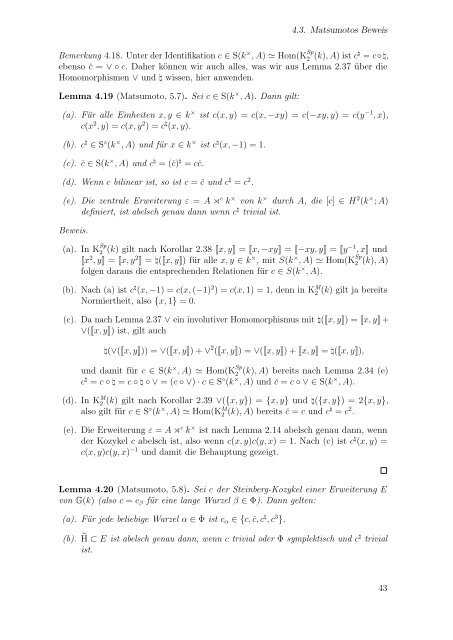Matsumotos Satz und A¹-Homotopietheorie - Konrad Voelkel
Matsumotos Satz und A¹-Homotopietheorie - Konrad Voelkel
Matsumotos Satz und A¹-Homotopietheorie - Konrad Voelkel
Sie wollen auch ein ePaper? Erhöhen Sie die Reichweite Ihrer Titel.
YUMPU macht aus Druck-PDFs automatisch weboptimierte ePaper, die Google liebt.
4.3. <strong>Matsumotos</strong> Beweis<br />
Bemerkung 4.18. Unter der Identifikation c ∈ S(k × , A) ≃ Hom(K Sp<br />
2 (k), A) ist c ♮ = c◦♮,<br />
ebenso č = ∨ ◦ c. Daher können wir auch alles, was wir aus Lemma 2.37 über die<br />
Homomorphismen ∨ <strong>und</strong> ♮ wissen, hier anwenden.<br />
Lemma 4.19 (Matsumoto, 5.7). Sei c ∈ S(k × , A). Dann gilt:<br />
(a). Für alle Einheiten x, y ∈ k × ist c(x, y) = c(x, −xy) = c(−xy, y) = c(y −1 , x),<br />
c(x 2 , y) = c(x, y 2 ) = c ♮ (x, y).<br />
(b). c ♮ ∈ S ◦ (k × , A) <strong>und</strong> für x ∈ k × ist c ♮ (x, −1) = 1.<br />
(c). č ∈ S(k × , A) <strong>und</strong> c ♮ = (č) ♮ = cč.<br />
(d). Wenn c bilinear ist, so ist c = č <strong>und</strong> c ♮ = c 2 .<br />
(e). Die zentrale Erweiterung ε = A ⋊ c k × von k × durch A, die [c] ∈ H 2 (k × ; A)<br />
definiert, ist abelsch genau dann wenn c ♮ trivial ist.<br />
Beweis.<br />
(a). In K Sp<br />
2 (k) gilt nach Korollar 2.38 [x, y ] = [x, −xy ] = [−xy, y ] = [y −1 , x] <strong>und</strong><br />
[x 2 , y ] = [x, y 2 ] = ♮([x, y ]) für alle x, y ∈ k × , mit S(k × , A) ≃ Hom(K Sp<br />
2 (k), A)<br />
folgen daraus die entsprechenden Relationen für c ∈ S(k × , A).<br />
(b). Nach (a) ist c ♮ (x, −1) = c(x, (−1) 2 ) = c(x, 1) = 1, denn in K M 2 (k) gilt ja bereits<br />
Normiertheit, also {x, 1} = 0.<br />
(c). Da nach Lemma 2.37 ∨ ein involutiver Homomorphismus mit ♮([x, y ]) = [x, y ] +<br />
∨([x, y ]) ist, gilt auch<br />
♮(∨([x, y ])) = ∨([x, y ]) + ∨ 2 ([x, y ]) = ∨([x, y ]) + [x, y ] = ♮([x, y ]),<br />
<strong>und</strong> damit für c ∈ S(k × , A) ≃ Hom(K Sp<br />
2 (k), A) bereits nach Lemma 2.34 (e)<br />
c ♮ = c ◦ ♮ = c ◦ ♮ ◦ ∨ = (c ◦ ∨) · c ∈ S ◦ (k × , A) <strong>und</strong> č = c ◦ ∨ ∈ S(k × , A).<br />
(d). In K M 2 (k) gilt nach Korollar 2.39 ∨({x, y}) = {x, y} <strong>und</strong> ♮({x, y}) = 2{x, y},<br />
also gilt für c ∈ S ◦ (k × , A) ≃ Hom(K M 2 (k), A) bereits č = c <strong>und</strong> c ♮ = c 2 .<br />
(e). Die Erweiterung ε = A ⋊ c k × ist nach Lemma 2.14 abelsch genau dann, wenn<br />
der Kozykel c abelsch ist, also wenn c(x, y)c(y, x) = 1. Nach (c) ist c ♮ (x, y) =<br />
c(x, y)c(y, x) −1 <strong>und</strong> damit die Behauptung gezeigt.<br />
Lemma 4.20 (Matsumoto, 5.8). Sei c der Steinberg-Kozykel einer Erweiterung E<br />
von G(k) (also c = c β für eine lange Wurzel β ∈ Φ). Dann gelten:<br />
(a). Für jede beliebige Wurzel α ∈ Φ ist c α ∈ {c, č, c ♮ , c 3 }.<br />
(b). ˜H ⊂ E ist abelsch genau dann, wenn c trivial oder Φ symplektisch <strong>und</strong> c ♮ trivial<br />
ist.<br />
43


